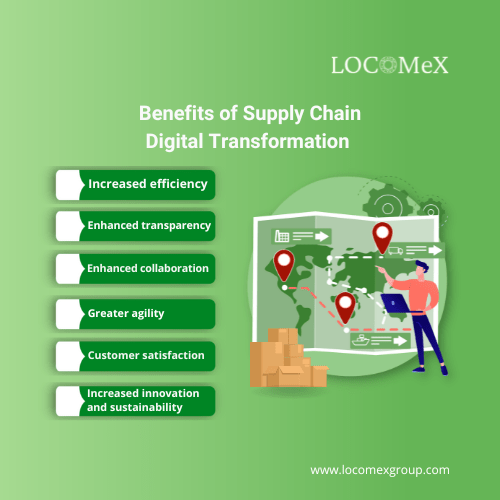176
In recent years, digital transformations have revolutionized how companies do business. By leveraging the latest digital technologies, businesses can optimize their operations and achieve greater efficiency, productivity, and profitability. One area where digital transformation has had a significant impact is the supply chain.
By implementing supply chain digital transformation, companies can gain greater visibility into their warehouse management, streamline operations, and make more informed decisions. It can help businesses to reduce costs, improve customer satisfaction, and gain a competitive advantage.
Regardless of the size of your business, digital technology offers a valuable opportunity to optimize your supply chain, stay competitive, and achieve greater success in today’s rapidly changing business environment.
Many organizations seek the aid of service providers to support them in their efforts for supply chain digital transformation, drive organizational changes, and implement new technologies that promote business growth.
Optimizing The Inventory Levels: The Objectives Of Supply Chain Digitization
In this context, understanding the goals of the digital supply chain is critical to leveraging digital transformation and legacy systems to drive business growth with the best AI-powered supply chain optimization software.
- Digitizing key supply chain processes, such as procurement, production, and logistics, to deliver higher-value digital solutions and provide cost optimization.
- Increasing the transparency and visibility of the supply chain by leveraging digital solutions such as the Internet of Things (IoT), blockchain, and advanced analytics, enabling businesses to track goods and materials throughout the distribution channels.
- Improving supply chain agility and responsiveness enables businesses to quickly adapt to changes in demand and improve digitization efforts, customer preferences, and future disruptions.
- Enhancing collaboration and communication across the supply chain, allowing for improved planning, execution, and monitoring of supply chain performance.
- Real-time monitoring and predictive analytics enable better risk management and prevent supply chain disruptions.
- Increasing sustainability by optimizing supply chain digital transformation to minimize waste, reduce carbon footprint, and improve overall environmental impact.
- Improving customer experience by enabling faster, more efficient delivery, greater product customization, and enhanced visibility and transparency throughout the digital supply chain.

Revolutionizing Inventory Management: The Benefits Of Supply Chain Digital Transformation
A market study found that “In 2022, the size of the worldwide supply chain management market was USD 21,129.2 million, and it is projected to grow at a compound annual growth rate (CAGR) of 11.1% from 2023 to 2030.” Therefore, the benefits of supply chain digital transformation include the following:
- Increased efficiency: Digital technologies can help businesses to optimize their supply chain processes, reducing lead times, streamlining processes, and reducing costs.
- Enhanced transparency: Digital transformation can give businesses greater reliability in their supply network, which helps them to track products and materials in real time, identify inefficiencies, and make data-driven decisions.
- Enhanced collaboration: Digital technologies can facilitate collaboration between different stakeholders in the supply chain, helping to improve communication, reduce errors, and speed up decision-making.
- Greater agility: Digital transformation can enable businesses to respond more promptly to changes in customer requests, supply chain disruptions, and other external factors, improving their ability to compete and succeed in a fast-changing business environment.
- Improved customer satisfaction: By optimizing the supply chain, businesses can improve their ability to deliver products to customers quickly and efficiently, enhancing customer satisfaction and loyalty.
- Increased innovation and sustainability: Digital transformation for the supply chain can help businesses to identify new opportunities for innovation in the supply chain, such as new products, services, or business models, and reduce their environmental impact and improve supply chain resilience.
Seven Crucial Ways In Which Digital Transformation Is Shaping The Supply Chain Management
In the current business landscape, it has become imperative for companies to have supply chains that are agile and resilient to stay competitive and successful. To achieve this, developing a supply chain transformation strategy is crucial, and organizations seeking to transform their global supply chains digitally may consider implementing the following seven steps:
- Increased visibility: Digital technologies such as RFID tags, GPS tracking, and real-time data analytics are enabling businesses to gain greater visibility and make accurate demand forecasting into their supply chain operations, helping them to identify areas for improvement.
- Enhanced collaboration: Digital transformation facilitates collaboration between different stakeholders in the supply chain, including suppliers, manufacturers, distributors, and retailers. It helps to improve communication, reduce lead times, and increase efficiency.
- Predictive analytics: By leveraging predictive analytics, businesses can use data to anticipate supply chain disruptions and proactively mitigate them. These can help to reduce costs and improve customer satisfaction.
- Automation: Advanced technologies such as machine learning and automation reduce the need for manual labor in the supply chain, improving efficiency and providing cost optimization.
- Customization: With the help of supply chain digital transformation, businesses can offer their customers more personalized products and services, increasing customer satisfaction and loyalty.
- Traceability: Digital technology such as blockchain enables businesses to track products throughout the supply chain, improving traceability and reducing the risk of fraud or counterfeiting.
- Sustainability: Supply chain digital transformation enables businesses to reduce their environmental impact by optimizing their supply chain operations, reducing waste, and using more sustainable materials and processes.
Choosing The Right Supply Chain Management
As the digitalization of supply chain management continues to evolve, the market is becoming saturated with various software solutions. With so many choices, selecting the right supply chain management software that fits your organization’s unique needs is crucial. Here are five key features to consider when making your selection:
- AI-powered digital solutions: The software should have automated processes to provide valuable data insights for better decision-making.
- Real-time visibility and collaboration: Monitoring and collaborating across the entire organizational structure is critical for enhancing efficiency and future delays across complex distribution channels.
- Integration with existing systems: It’s important that the software can seamlessly integrate with existing systems to avoid disruption and streamline operations.
- Cloud-based scalability: Cloud computing adoption offers the flexibility and scalability needed to support a growing business without costly hardware upgrades.
- User-friendly interface: The best supply chain optimization software should have an intuitive interface that is easy to navigate, ensuring user adoption and maximizing productivity.
Primary Conclusions
Embracing supply chain digital transformation is crucial for organizations to stay competitive in the rapidly evolving economic landscape and meet the changing demands of customers. To thrive in the future, businesses, non-profits, and institutions must undergo digital transformation, and companies that resist this change will eventually become obsolete.
As the supply chain evolves, it will drive innovation, foster competition, and improve customer service. Companies must enhance their inventory and asset management practices through automated warehouses to remain competitive.
Introducing LOCOMeX, a leading supply chain optimization provider that has pioneered integrating data-driven solutions with artificial intelligence. Their expertise is helping supply chain organizations sustainably and ethically enhance their manufacturing operations while achieving strategic objectives.
Hurry! Contact them today to grab the best supplier plan..




